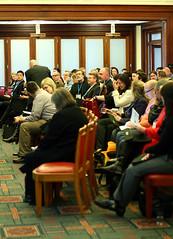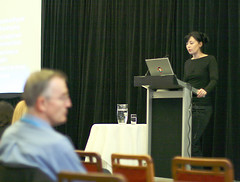Nathanael Boehm is reporting for SitePoint from Web Directions Government 2008, in Canberra Australia.
 It was a chilly start to the day with the temperature hovering just above zero degrees as we waited in the dining area of Old Parliament House, cups of coffee in hand, listening to people who’d attended the breakfast session tell us how good Jason Ryan’s presentation had been. Jason is currently Communications Manager at the State Services Commission in New Zealand and presented on “Government 2.0: The public management challenge”. Unfortunately I didn’t get a chance to meet Jason however I did talk with one of his colleagues at the State Services Commission Rowan Smith who is involved with the New Zealand Government Web Standards project.
It was a chilly start to the day with the temperature hovering just above zero degrees as we waited in the dining area of Old Parliament House, cups of coffee in hand, listening to people who’d attended the breakfast session tell us how good Jason Ryan’s presentation had been. Jason is currently Communications Manager at the State Services Commission in New Zealand and presented on “Government 2.0: The public management challenge”. Unfortunately I didn’t get a chance to meet Jason however I did talk with one of his colleagues at the State Services Commission Rowan Smith who is involved with the New Zealand Government Web Standards project.
At 9:00am John Allsopp opened the conference and talked about how the focus of these conferences has expanded and is no longer about accessibility and other technical low-level issues. Although these are still as relevant and important now as 5 years ago the adoption and integration of best practice in those areas has reached a point where can move onto the next big thing, which for this conference was eGovernment: how government communications and collaborates online internally, with other agencies and with the public and citizens as well as the delivery of services online. He emphasised that we, the participants and active members in the web industry, are key in driving that change and moving towards having two-way communication between the government and the citizens that government serves.
José Manuel Alonso from the W3C on eGovernment standards
The first presenter for the day was José Manuel Alonso, eGovernment Lead at the Worldwide Web Consortium (W3C), working out of the W3C’s office in Spain. José covered in detail many aspects of the technical challenges with deploying government services and information over the web. He quoted research that stated 29% of people would prefer to communicate with the government via the Internet but that more needs to be done, including improving the content and design of government websites.
José talked about the interoperability framework, open standards and the fact that even transferring data between systems using XML even if using similar or identical schema models may not be enough. He explained that in Europe there are some interlingual issues with differences of meaning and interpretation of words so even if organisations in separate countries agreed on a single XML schema that there may still be confusion or differences of interpretation of shared information.
He then discredited the idea of one-stop shops and cited a report that in 2007 searches for five top news stories in Google rated blogs higher than the New York Times, showing the change in how people find and access information. José also quoted Brian Humphrey and Ron Myers of the Los Angeles Fire Department (LAFD) who said “We can no longer afford to work at the speed of government. We have responsibilities to the public to move the information as quickly as possible so that they can make key decisions”. If you can’t do something useful with your data and information, put it somewhere where someone else can! He then listed a few examples of both organisation collaboration with third parties as well as third parties transforming and mashing up data and information, including the Library of Congress’ project with flickr, USPOT’s Peer Reviewed Prior Art project, FixMyStreet, Follow the Money, MapLight, OpenCongress, GovTrack and TheyWorkForYou (after José’s presentation I went and let him know that Australia now has a soon-to-be-launched version of TheyWorkForYou called OpenAustralia).
He finished off his presentation by looking at some of the challenges and opportunities with mash-ups and sharing data such as privacy and security, semantic technologies, linked data such as RSS and RDF and the importance of ensuring and guaranteeing the authority of data, and don’t forget about developing for the mobile platform!
The W3C has an eGovernment proposal out to its membership for review, which concluded today — the results of that review should be known within a couple of weeks and if (as is expected) the W3C membership give the green light to the W3C’s eGovernment initiative then an Interest Group will be set up shortly to start looking at this in more detail and look at establish standards around eGovernment.
Finally, José stated that eventually the “e” should be removed from eGovernment — once web services become an integral part of government and no longer treated as an optional add-on but a core component of how government operates, communicates and provides services. That’s what we’re aiming for.
Jenny Telford the Australian Bureau of Statistics on opening government data
The next presentation was by Jenny Telford, Director of Products and Services from the Australian Bureau of Statistics (ABS) who went through in some detail the work that the Bureau has done over the last few years and the transition from (can you believe it) charging people to access Census data online to the situation today where they have a number of tools, reports and data formats available with some quite powerful data extraction configuration capabilities.
One of the reporting functions available allows advanced users to access and aggregate individual “units” of Census data. Although no names and addresses are exposed the ability to aggregate data and compare with other sources could potentially allow people to get access to private information so they’ve had to employ some advanced algorithms to protect people’s privacy.
She admitted the Bureau still has a way to go with further opening data, increasing geospatial reporting capabilities and looking at their copyright and intellectual property (IP) protection policy. Currently there is a 500 cell limit on some reports as a rudimentary means of preventing large-scale collection of data — a measure she admits needs to be looked at.
Some of the questions asked after Jenny’s presentation included the culture shift of Generation Y and growing indifference about the disclosure of personal information and how this might be reflected in future Censuses, as well as questions about utilising communities to validate and augment information in the Bureau’s databases.
Ralph Douglas from GovDex
Ralph was next with a brief 25 minute presentation on GovDex (which I missed half of as I was talking to Amit from the W3C Canberra office about getting involved in the Consortium’s eGovernment Interest Group). GovDex is a government-run secure (classified as IN-CONFIDENCE, with plans to have a PROTECTED version by the end of the year) online collaboration tool which allows internal, cross-departmental and government-community groups to connect and share ideas online using a wiki facility and a member registration/information database. Unfortunately the presentation was a bit light-on and dry; I didn’t get much out of it, although the application looked like it could be useful.
Lisa Herrod from Scenario Seven on usability
 Lisa Herrod’s presented on usability “More than skin deep” — a presentation I’d seen before at last year’s Web Directions South conference in Sydney, but nonetheless just as good the second time around with practical ideas on how to take a holistic approach to usability, how it ties into the code and accessibility, how automated accessibility compliance checks are not enough and the idea of an Accessibility User Profile as part of your persona development. Considering people with disabilities as a primary user group ensures their requirements are considered throughout the development of a website rather than a feeble and rushed attempt to retrofit a finished site for WCAG compliance at the end of the project.
Lisa Herrod’s presented on usability “More than skin deep” — a presentation I’d seen before at last year’s Web Directions South conference in Sydney, but nonetheless just as good the second time around with practical ideas on how to take a holistic approach to usability, how it ties into the code and accessibility, how automated accessibility compliance checks are not enough and the idea of an Accessibility User Profile as part of your persona development. Considering people with disabilities as a primary user group ensures their requirements are considered throughout the development of a website rather than a feeble and rushed attempt to retrofit a finished site for WCAG compliance at the end of the project.
Matthew Hodgson from SMSMT on social computing
Matthew was up next to talk about social computing in government, a really good presentation that started with a story of a project he was involved with some time ago to introduce a wiki in an unnamed government department. The aim was to enable collaboration between different sections within the department with an aim to address serious knowledge sharing and efficiency issues that the wiki implementation group he was involved with had identified. Unfortunately once senior management found out about the wiki and that sections of the department weren’t going through the proper channels to have information approved and signed-off for dissemination (even just internally) the wiki was shut down.
He likened some organisations to Darth Vader — the need for control, to lock down everything. Why would average people know what information they want? He also provided an interesting statistic: that 100 million hours of knowledge have gone into Wikipedia … the same number of hours that Americans collectively spend watching TV commercials every weekend! If only people put their time to better use in contributing to global knowledge through collaboration projects like Wikipedia or productive and problem-solving projects like Appropedia, the sustainability wiki.
People are social creatures — they need to have that social need met and there are ways of meeting that need in a work context (Matthew referred to Maslow’s Hierarchy of Needs) — it’s not about wasting time socialising with friends. Communities and networks aren’t necessarily geographic — if they were then you would communicate face-to-face with those in your network (like we were at the conference). However for people who’s networks are based around an interest or otherwise then the fact that those networks function online doesn’t take away the fact there still needs to be a social element to those interactions.
Robert Hoekman Jr. from Miskeeto on usability and minimalist design
The final presentation for the day was by Robert Hoekman Jr. all the way from Phoenix, Arizona, who opened with a declaration that there are still a lot of awful sites out on the web — sites that make users feel dumb, unable to quickly and intuitively figure out how to use a web interface and how sites have all these features crammed into them that doesn’t make them better, it just makes them more complicated to use and learn.
His classic line was “Understand users, then ignore them” — going on to explain that you need to understand users’ needs but that people don’t always know what they want or say things that don’t truly represent how they might use something in a real-life situation. He used an example of a fast food chain that introduced a lo-carb cheeseburger which during user research sounded like it would be quite popular but when put on the menu didn’t do to well at all. Sites need to support an activity or range of activities, not the audience types. Your user research should determine the essential requirements of your users but not over-scrutinise your users and attempt to cater for the needs of every single possible user type.
Robert then talked about minimalist design — building only what is absolutely necessary: “Once you start putting real glass windows in your tree house, you’ve lost the point of what a tree house is meant to be”. Ever get sick of using a hammer? A hammer has a well-defined purpose and you are unlikely to pick up a hammer expecting it to do something else, which also means the hammer never disappoints because it does exactly what it was designed to do — and nothing more.
He referred to a couple of case studies including the WordPress home page and Squidoo website and how changes to the page design to make it simpler and more obvious had real, measurable effects on site usage.
He gave some further good one-liners of advice including “Turn beginners into intermediates. Immediately” (referring to how sites should be intuitive to use and immediately empower the user), “Design for uniformity, consistency and meaning” and “Reduce, reduce, reduce and refine” … including only what elements are necessary and having conscious decisions behind the placement of every aspect and feature on a page.
Finally …
John then took the stage to wrap up the conference, again thanking the sponsors of Web Directions South Government 2008 including SitePoint and the presenters. I asked a few people for their thoughts on the conference and the response was positive, although several said they were expecting more of a government focus — an opinion I shared, although it was hard to get out of anybody exactly what being more government focussed might entail. Afterwards I discussed this further with Maxine (one of the conference organisers) and concluded that people want more emphasis on the context of government; the particular and peculiar challenges of working in a strong hierarchy with decades of embedded top-heavy culture, procedure and culture, the wariness of innovation and especially social computing. This could be incorporated into the conference through more case studies of government projects and more presentations by people who actually have experience working inside government who can relate to the pain felt by those “on the inside” trying to do good work, building accessible and usable websites, applying best practice in design, user research and testing.
Of the four presentations I missed out on I had a chance to speak with Scott Gledhill and David Hayward afterwards to get a synopsis of their presentations. Scott’s was a follow-on from the article he had published in the Digital Web Magazine on Corporate Web Standards and the sad reality (or interesting challenge) of implementing web standards in an environment where time and efficiency are the priority. David presented on exploiting geospatial data, using a case study of the development of the NSW Government’s Spatial Information eXchange SIX Gateway site.
All in all though, another great Web Directions conference organised and run by John, Maxine and the crew which will inspire me (and I hope others) for many days to come.
For more information about the conference, program and speakers go to the Web Directions South Government 2008 website.


